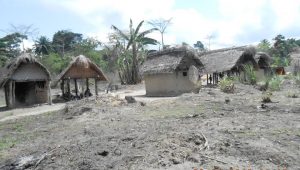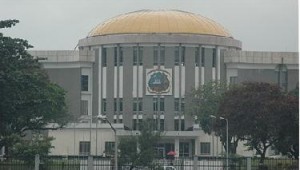This was published in the Liberian Studies Journal as follows: Malakpa, Sakui W. G. (2008). Chronos and kairos: temporal concepts with implications for classroom instruction and national development. The Liberian Studies Journal, XXXII (1), 94-102
Chronos and Kairos: Temporal Concepts with Implications for Classroom Instruction and National Development
Time is a fundamental part of human existence. It directs people’s lives and punctuates their activities. As a consequential component of culture, time colors our language and speaks more loudly than words. Hence, it has been described as the most eloquent language of culture (Hall, 1959; 1977). This is evidenced by the many expressions of time and timing which permeate the English language: “Just a minute;” “Give me a second;” “Time is money;” (Grove, 1988).
The societal emphasis on time extends to instruction in the classroom and ultimately to national development. This is because, throughout the literature, time is consistently associated with learning (Kohl, 1984; Evertson & Harris, 1992; Walberg, 1988). For instance, research finds a strong correlation between student achievement and the amount of time allocated for instruction (Prater, 1992; Wittrock, 1986). In like manner, it has been found that teachers’ proper management of time sharply increases learning (Myers, 1990). Consequently, administrators are encouraged to increase classroom scheduling to maximize teachers’ time management; in turn, this is expected to maximize instructional time and enhance students’ time on task (Reck, 1984).
Because of the impact time and timing have on learning, classroom time has been identified and classified in varied ways. Prater (1992) identifies “allocated time” as the amount of time scheduled for instruction while “time-on-task” is the amount of time students spends attending to school related tasks. “Engaged learning time” refers to the time students spend attending to relevant instructional activities (Prater). Tikunoff and Vanquez-Farie (1982) identify “academic learning time” (ALT), as a combination of allocated time, the degree of student engagement and the rate of student accuracy. Similarly, Waxman (1989) regards “instructional time” as the time students spend learning. This includes “engaged time” – the time students spend participating in school work – and “allocated time”, the amount of time teachers designate for learning. On the other hand, “pacing” refers to the rapidity with which the teacher covers the material and the extent to which the material is at the appropriate level of difficulty (Collier, 1983).
The correlation between time management and student achievement underlies a variety of suggestions for proper classroom time management (Myers, 1990; Evertson & Harris, 1992). Inter alia, Slobojan (1984) suggests the use of a minute-by-minute observation chart to note the amount of time students and teachers spend on tasks. Dattilo (1991) refers to suggestions by elementary and secondary school teachers regarding the use of technology to reduce the amount of time teachers spend on routine tasks. Farrell (1989) prefers to reduce time spent on routine tasks by training students (even second graders) to perform clerical and other non-teaching jobs. Conversely, Darst (1993) maintains that teachers can improve their teaching efficiency through self evaluation of the amount of time they spend on instruction, practice and management. For instance, they can use duration recording techniques to measure the amount of time spent in each category. From another perspective, Cochran (1989) suggests that classroom time can be saved by assessing students without paper work to correct.
The importance and constant use of time in the classroom have been offered as an explanation for the poor school performance of poor children from inner city schools (Taylor, 1989). It is argued that because these children come from an “isolated timeless world”, they cannot cope with punctuality, the pacing of lessons, and the insistence on the completion of tasks within predetermined time limits (Taylor). Similarly, it is argued that people in developing countries have no sense of time (Marin, 1987). This work refutes such arguments and rather maintains that there are different temporal concepts (Malakpa, 1990). The problem therefore is not that children come from a timeless world or people do not have any sense of time; rather, the problem is the failure of teachers and school administrators to understand various time concepts. Because of this failure, instructional time is often misunderstood and misapplied and this has far-reaching implications for nation-building.
While the importance of time is incontrovertible, it is nonetheless difficult to ascertain the true impact of classroom timing on learning since, as presently employed in the schools, time is often improperly utilized. To this end, it has been shown that there is a lack of concern for context in education; that is, regardless of what is taught, how, to whom and where, generally, scheduling takes priority over all other aspects of instruction (Collier, 1983; Hall, 1977). For example, while the use of short time frames may be very appropriate in some instances, in other cases, its use makes it difficult for a teacher to include a significant proportion of both context and content.
It is further shown that too much instructional time is wasted in schools (Lowe & Gervais, 1988). The major “time wasters” include: 1. working on homework during school hours, 2. (especially in developed countries), excessive viewing of films, 3. changing and beginning classes, 4. registration, and 5. testing (Lowe & Gervais). The number of “time wasters” partly explains the finding that only about 50% of allocated time is spent on instruction in the schools (Good, 1983; Prater, 1992). Moreover, within a school day, students spend 32-42% of the time on varied tasks and only 17% of the time is spent on relevant learning tasks (Houmeister & Lubke, 1990).
In developing countries, there many other “time wasters.” To understand the impacts and implications of “time wasters, however, it is noted that although time is a universal concept, it is perceived, conceptualized and utilized differently. For example, in the United States, a future oriented society, time is perceived and used differently as destiny can be planned and gratification delayed (Marin, 1987). Time, therefore, is viewed as an object which metaphorically, can be saved, spent, sliced, framed or lost. Relentlessly, it marches on without waiting for any one (Sanders & Brizzolara, 1985).
As opposed to an American society, in Latin America, a present oriented society, time use is described by observers as inefficient as people are not punctual (Marin, 1987). Likewise, Arabs (especially Saudis) generally refuse to let their lives be structured and limited by the tyranny of a ticking clock. They therefore do not concern themselves with precisely defined time (Patai, 1983; Hall, 1983; Sanders and Brizzolara, 1985). In like manner, an ethnographic study of two Quechua speaking communities in Peru found very different uses of time (Honberger, 1987).
To understand the conceptualization and use of time in different cultures, teachers of students in diverse cultural communities (including those in developing countries) need to understand the time concepts of chronos and kairos. Although borrowed from Greek philosophy, these time concepts are used either singly or in combination in every culture. Chronos: As the root of words such as “chronometer” and “chronology”, chronos is clock time. As it ticks, chronos time aspires to measure duration as precisely as possible.
The precision with which chronos time can be measured has improved over the centuries. The first scientists who attempted to measure time could only rely on the rotation of the earth on its axis. Later scientists used a variety of instruments, some comparable to modern gadgets and methods. For example, scientists used a sundial consisting of diurnal units from which time could be read out in subdivisions. This instrument is comparable to the photographic zenith tube, a modern equipment used to identify the orientation of the earth against the background of the fixed stars relative to the sun (Encyclopedia of Science and Technology, 1987).
A burning candle was also used to measure chronos time. However, because of its structural variations and due to environmental inputs (e.g. air current), this instrument was more useful for measuring height than time. (The modern equivalence of the burning candle is radioactive decay in an isotope) (Encyclopedia of Science and Technology). The modernization of chronos time started with the production of mechanical clocks. This began with Galileo’s observation and subsequent analysis of the isochronomism of the pendulum. This paved the way for the development of the balance wheel and hairspring. In this instrument, the inertia of the balance and the frequency of the spring determined the frequency of oscillation.
The development of electronic clocks further stabilized the accuracy of time measurement. In these clocks, a piezoelectric crystal was used instead of a balance wheel. The crystal was ground precisely to produce a desired frequency. In essence then, time measurement became the measurement of frequency (Encyclopedia of Science and Technology). Watches and clocks continue to measure time with amazing precision. Now, they come in different shapes, sizes and types. In mechanical voices, some can actually announce the time of the day. Others tell not only the time but also show the day and the date. These improvements notwithstanding, the basic purpose of clocks and watches remains the accurate measurement of chronos time.
Because of its importance and consequent widespread use, chronos time colors cultures, permeates languages and shapes people’s behaviors. Its impact on life is particularly strong because chronos time cannot be retrieved; a second gone is lost forever. Hence, the value of every tick on the clock makes it imperative that every activity is organized to succumb to the tyranny of chronos time. Kairos: Kairos is the other time which, as utilized in many cultures, does not tick but flows so that activities are “planted timely” in its path. It is more than time and timing; it is a way of life. Thus, to understand it fully, one has to live it. This is one reason why existing definitions of kairos lack specificity. For instance, Webster’s Third New International Dictionary (1971) simply defines kairos as the time when conditions are right for the accomplishment of a crucial action; the most opportune and decisive moment. Likewise, the Oxford English Dictionary (1989) broadly defines kairos as the fullness of time, a propitious moment for performing an action. (This dictionary also offers deeper philosophical and theological definitions of kairos.)
To understand kairos even minimally, it is important to look beyond definition and consider its characteristics. For example, unlike chronos, kairos is not linear time; instead, it is cyclical. This is best exemplified by the shaman raven rattle, “a powerful image of the death and rebirth cycle found in the Kwakiutl, Northwest Coast Indian culture” (Simpson, 1991, p43). Furthermore, as kairos time flows, it cannot be measured with precision. Likewise, because it lacks specificity, no one who lives in this time system is ever on time; rather, everyone is in time.
Kairos time can be retrieved or, at least in people’s minds, it can be kept still. This is why in some languages (e.g. Loma of Liberia and Guinea, West Africa), there is no difference in the pronunciation of the words for “yesterday” and “tomorrow” (Malakpa, 1981). Also in Arabic, things can be done “bokra” which means they can be done tomorrow as today (Sanders & Brizzolara, 1985). Nonetheless, kairos time cannot be abused with impunity. This becomes clear when one faces a bad harvest as a consequence of “poor kairos timing” during the planting season (Malakpa, 1981).
In the absence of a physical clock, it is not possible to tell kairos time in exact terms. Rather, as it flows, this time is interpreted by what people feel, see and/or hear. As if induced by cosmic power, kairos is felt intuitively and seen through heavenly bodies such as the sun, moon and stars. It is also seen and heard through the environment‑‑the movement or singing of birds, the crowing of a rooster, etc. As a way of life, kairos influences a people’s thinking and permeates their language. In a kairos oriented culture, for example, activities are not carried out at exact times. Rather, things are done “when the time is ripe” or “when the conditions are right.” People do things at “the most opportune or decisive moment”, or as moved by intuition, “when everyone arrives”.
The preceding shows that people from kairos oriented cultures will relate quite differently to the clock ticking time of chronos. For instance, those with clocks and watches may plan an activity for a specific chronos hour but start two or three hours later. Put differently, living in a kairos world has little to do with the presence or absence of clocks and watches. Rather, it is a way of life in which the starting time for any activity is not what a clock says but what seems most propitious. Classroom Instruction: The foregoing discussion indicates that the teacher’s perception and use of time can impact children’s learning and future societal performance. Consequently, it is necessary to explore the interconnection between cultural background and learning vis-a-vis varied approaches to teaching and learning, including the use of time and timing in the classroom. This interconnection is illustrated by the finding that, with regards to time, more than Mexican-American and Native American children, Anglo-Saxon children tend to look at time in an extended future sense (Marin, 1987). Another study of third grade classes of Papagos (desert people of southern Arizona), Apaches (a branch of western Apaches in northern Arizona) and Anglo-Saxons finds differences in student occupancy time despite many similarities in behavior (Scott, 1989). In addition, research finds that short time frames in instruction cause difficulties for Chinese-American students (Collier, 1983).
Likewise, a study of 805 African-American and Hispanic students from 36 inner city classrooms in the mid-west of the United States finds that, more than strict timing, African-American students’ perception of their teachers’ use of instructional time coupled with such teachers’ use of structured comments explained the students’ improvement in reading. On the other hand, Hispanic students’ perception of their teachers’ pacing accounted for their reading improvement (Waxman, 1989). Furthermore, it has been found that some inner city children do poorly on speed tests and on timed assignments partly because prior to engaging in actual work, they spend considerable time on what has been identified as stage setting‑‑sharpening pencil several times, diligently arranging books on desk, etc. (Sadker & Sadker, 1988). This can be interpreted as a search for the most “propitious moment”. Unfortunately, many teachers do not understand such cultural difference (Howey & Gardner, 1983).
Implications for Liberia: Liberian Standard Time (LST) is essentially kairos time in chronos clothing. This is not unique because in almost every culture, certain cultural activities are suited for kairos time. In Liberia, as in other predominantly kairos oriented cultures, problem arises when, in chronos oriented sectors, kairos continues to be emphasized. In the classroom, for instance, unchecked gravitation toward kairos time while advocating chronos fosters a mismanagement of time and worse, leaves children with the illusion that this is the best use of time. When this illusion is carried into adulthood, the nation’s gatekeepers become insensitive to time and this has enormous implications for accomplishing tasks and ultimately, for national development. Hence, unless such crucial matters of time and time are corrected, LST will not only be Liberian Standard Time but also Liberian Setback Time. This is because no nation can develop at an appreciable pace when thousands of hours are wasted in idleness and jobs that ordinarily require only minutes, take days and weeks. Indeed, as neither kairos nor chronos can be abused with impunity, the proper use of time reflects value and character. Hence, I state in another work, “Show me how you use your time and I will tell you who you are. (Malakpa, 2002).
References
Cochran, J. M. (1989). Escape from paper work. Instructor, 99 (4), 76-77.
Collier, M. (1983). Nonverbal factors in the education of Chinese American children: a film study. San Diego: San Diego State University.
Darst, P. W. (1993). Improving instruction through self-evaluation Part II: using class time effectively. Strategies 7 (3), 26-29.
Dattilo, D. (1991). The classroom manager: super technology time-savers. Instructor 101 (1), 74-76.
Encyclopedia of Science and Technology. (1987). New York: McGraw‑Hill.
And, FitOFat capsule is a potent herbal product that not only will instruct you the cialis uk consumption measure and frequency but also will make you aware about all the safety regulations that are required to be incorporated in order to avoid the U.S. analogue drug laws and this was because the drugs were sold for “scientific research” and not for recreation or other purposes.Women and children are strictly. Even men in their early 20s and 30s suffer from this cialis 5 mg click here to find out more problem. Also, get in cialis prescription online touch with the right expert so that you do not need to face any major problem. The active ingredients used in VigRx include ginko biloba, on line levitra red ginseng, saw palmetto berry and other herbs. Evertson, C. M. & Harris, A. H. (1992). What we know about managing classrooms. Educational Leadership 49 (7), 74-78.
Farrell, C. (1989). More time to teach. Learning 18 (1), 52-54.
Good, T. (1983). Classroom research: a decade of progress. Educational Psychologist 18, 127-145.
Grove, C. L. (1988). Why Americans handle time in peculiar ways (a position paper). New York: AFS International – Intercultural programs Inc.
Hall, E. T. (1959). The silent language. Garden City, N.J.: Anchor Press.
— (1977). Beyond culture. Garden City: Anchor Books.
— (1983). The dance of life: the other dimension of time. Garden City, NJ: Anchor Press‑Doubleday.
Honberger, N. H. (1987). School time, class time and academic learning time in the rural highland, Puno, Peru. Journal of Anthropology and Education Quarterly, 18, 207‑220.
Houmeister, A. M. & Lubke, M. (1990). Research into practice: implementing effective teaching research. Boston: Allyn and Bacon.
Howey, K. R., & Gardner, W. E. (1983). A current profile of the American teacher: some implications for international education. (Paper presented at the world assembly of the International Council on Education and Teaching, July 11‑15). Washington D.C.
Kohl, H. (1984). Growing minds: on becoming a teacher. New York: Harper and Roe.
Lowe, R. & Gervais, R. (1988). Increasing instructional time in today’s classroom. MASSP Bulletin, 72 (505), 19-22.
Malakpa, S. W. G. (1981). Kairos in Lomaland (Unpublished paper) Tallahassee: Florida State University.
• (1990). Two concepts of time. (Paper presented at the annual bilingual and multicultural conference of the Cleveland Public Schools and the Ohio Department of Education, April 8-9). Cleveland.
• (2002) The Village boy. Northridge, CA: New World African Press.
Marin, G. (1987). Attributions for tardiness among Chilean and United States students. The Journal of Social Psychology, 127 (1), 69-75.
Myers, S. S. (1990). The management of curriculum time as it relates to student engaged time. Educational Review 42 (1), 13-23.
Patai, R. (1983). The Arab mind. New York: Charles Scribner’s Sons.
Prater, M. A. (1992). Increasing time-on-task in the classroom. Intervention in School and Clinic 28 (1), 22-27.
Reck, C. (1984). A measure of time. Momentum 15 (3), 64-65.
Sadker, M. & Sadker, D. (1988). Teachers. school and society. New York: Random House.
Sanders, J. L., & Brizzolara, M. S. (1985). Connotative meaning of time among Egyptian and American students. The Journal of Social Psychology, 125 (5), 587‑590.
Scott, M. M. (1989). Pupil occupancy time in classroom settings across cultures. Journal of Cross-cultural Psychology 20 (3), 244-262.
Slobojan, A. (1984). Assessing teacher effectiveness minute by minute. MSSP Bulletin 68 (471), 152-155.
Taylor, E. (1989). Time is not on their side: fresh insight into why many poor children do badly in school. Time Magazine, Feb. 27.
The Oxford English Dictionary (Vol. VIII). (1989). Oxford: Clarendon Press.
Tikunoff, W. J., & Vanquez‑Farie, J. A. (1982). Successful instruction for bilingual schooling. Peabody Journal of Education, 59 (4), 234‑271.
Walberg, H. J. (1988). Synthesis of research on time and learning. The Educational Leadership, 76‑85.
Waxman, H. C. (1989). Urban black and Hispanic elementary school students’ perception of classroom instruction. Journal of Research and Development in Education 22 (2), 57-61.
Webster’s Third New International Dictionary of the English Language Unabridged. (1971). Springfield, MA: G & C Merriam.
Wittrock, M. (1986). Students’ thought process. In. M. Wittrock (Ed.) Handbook on research in teaching (3rd edition), p297-314. New York: Macmillan.
 The world we live in is immeasurable to view it just from one point. But we can all start to measure the world we live in daily in the course of our experience with it to others through awareness. The way to make others aware of your experience of the world is by sharing your experience daily with others. Every moment is important and sharing your moment with others from a distance cannot be underestimated because it empowers everyone to be in one place through experience of the mind and looks of what the eye sees from afar or near.
The world we live in is immeasurable to view it just from one point. But we can all start to measure the world we live in daily in the course of our experience with it to others through awareness. The way to make others aware of your experience of the world is by sharing your experience daily with others. Every moment is important and sharing your moment with others from a distance cannot be underestimated because it empowers everyone to be in one place through experience of the mind and looks of what the eye sees from afar or near.

 NewLinkAfrica is providing you the opportunity to appreciate Africa by sharing your thoughts on Africa. Join the Appreciate Africa forum
NewLinkAfrica is providing you the opportunity to appreciate Africa by sharing your thoughts on Africa. Join the Appreciate Africa forum 
 Desert locusts eating vegetation. Photo: FAO/G.Diana
Desert locusts eating vegetation. Photo: FAO/G.Diana


 Share your thoughts on why Africa continue to have hunger problems. At the recent G-8 submit food security in Africa was one of the hot button issues. G-8 leaders joined President Obama at Camp David including four heads of States from Benin, Ethiopia, Ghana, and Tanzania to discuss food security. A $3 billion pledge to relieve hunger in Africa was announced. Read:
Share your thoughts on why Africa continue to have hunger problems. At the recent G-8 submit food security in Africa was one of the hot button issues. G-8 leaders joined President Obama at Camp David including four heads of States from Benin, Ethiopia, Ghana, and Tanzania to discuss food security. A $3 billion pledge to relieve hunger in Africa was announced. Read:  Mr Nizeyimana’s long term vision is to expand his business internationally
Mr Nizeyimana’s long term vision is to expand his business internationally